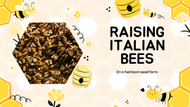Raising Italian Honeybees on an Heirloom Seed Farm
Posted by Jennifer Dixon on 4th May 2020
Raising Italian bees on an heirloom farm has been a goal of ours for some time now. I am convinced bees are one of God's most amazing creations. The bees we raise are Italians which are widely know for their gentle nature and abundant honey production. They also tolerate our winters here in the rural Blue Ridge mountains. Bee populations have been in decline for some time now due to a variety of theories. Personally I believe this decline is due to the pesticides being used commercially which can cause disorientation in bees among other health issues.
Regardless of the reason for the decline the impacts have been very dramatic. In California the impact has been so dramatic that farmers are actually trucking in bees from across the country to pollinate their farms. Some crops grown such as almonds are heavily reliant on bees for pollination. One third of all our food is pollinated by bees so keeping bees can truly have a great impact wherever you are.
Bees hives are truly fascinating to watch. They queen is the most important member of the hive as she is the only one that can lay worker bees. Without a queen the hive would cease to be. The workers however are just as important due to the fact that they feed, guard, build, and clean the hive. Without the workers the hive would also cease. In the summer and spring worker bees only live for around 40 days or so they simply wear out from working. All workers including foragers are female. Males are simply for breeding with a queen they do no work whatsoever. The queen can live 3 to 5 years depending on a number of factors. The workers are kept from laying due to the smell of the queen. If a hive grows to large and the queen runs out of room to lay she will leave the hive and the bees will follow her which is known as swarming.
Honey is another wonderful reason to keep bees. Honey is made from the nectar of flowers. The bees digest the nectar in a separate stomach where enzymes are added to convert the nectar into honey. Once the honey has been placed in comb cells the bees fan the honey to evaporate the water. Once most of the water has evaporated then the honey is "capped" or sealed until further use. It takes millions of flowers to make one pound of honey. When bees find a new food source they communicate with the other bees by what is known as the "waggle" dance. It tells the bees where to find the new food. We witnessed this a few days ago when working with the bees. It's an amusing display!
The health benefits for honey are vast. Honey is anti fungal, antibacterial, contains healing properties both for outside and inside the body. Raw honey especially Tupelo honey is better on the glycemic index than white sugar which makes it a healthier choice for sweeteners.
So the bees have been a welcome addition to our small farm. Hopefully as time progresses we will be able to add more hives to our area. We will see how this winter goes as winter time can be hard on honeybees, but with some diligence on our part and with God's blessing hopefully they will make it through the cold time of the year.
Well I hoped you enjoyed reading about honeybees and if you are able to raise bees I would definitely recommend adding them to your homestead.

